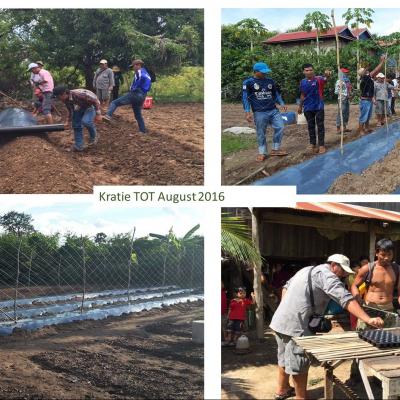CEDRIG Operativo
Informe PDFCambodian Horticulture Project Advancing Income and Nutrition (CHAIN) Phase I
Resumen
Información general
Autor
Moritz Krüger
Última actualización
Noviembre 2020
Objetivo general
Promotion of horticulture value chains in Preah Vihear, Stung Treng, Kratie and Oddar Meanchey provinces, with a strong focus on women and delivering sustainable income growth and improved household food security and resilience
País
- Camboya
Presupuesto
CHF 4.000.000
Duración
01.12.2014 - 30.11.2017 (Phase I)
Resumen
Descripción
In Cambodia, more than 40 % of the rural poor suffer from food insecurity. The increasing market demand for vegetable and fruits provides a huge opportunity for small holder farmers and processors, in particular women to increase income and food security. The Cambodia Horticulture Advancing Income and Nutrition (CHAIN) project supports farmers and processors in increasing sustainable production, income and resilience in four of the poorest provinces of Cambodia - Kratie, Stung Treng, Preah Vihear and Oddar Manchey. With the particular focus on the fruits and vegetables sector, CHAIN tackles market system constraints to improve the service delivery to poor farmers households, women headed households and ethnic minorities. CHAIN will support smallholder farmers to diversify into growing fruit and vegetables through the introduction of modern horticultural techniques and market linkages required to generate much-needed additional income, and it will also address poor household nutrition by supporting a diversification of diets.
Términos clave
- agriculture and food security
Sectores de Intervención
- Agricultura
- Seguridad alimentaria
- Desarrollo rural
- Gestión del agua
Documentos
Imágenes
Logos



Perspectiva del riesgo
Amenazas que se producen debido a la degradación del medioambiente
Nombre de la amenaza
Plagas y epidemias
Consecuencia
Loss of income and crop production
Descripción de la consecuencia
The invasion of flea beetle larvae (Chrysomelidae: Alticini) leads to a severe destruction of vegetables, especially root and leaf vegetables. Flea beetles execute their most severe attacks during dry weather and are most active on sunny days. Occurrence increased in the past 3-4 years.
Grado
Perjudicial
Vulnerabilidades
Increased pressure on smallholder farmers and income, loss in crop and vegetable production, low means of savings, limited knowledge of mitigation measures.
Probabilidad
Probable
Importancia
Riesgo medio
Riesgo seleccionado
SíMedida seleccionada
SíMedida seleccionada
SíAmenazas naturales (hidrometeorológicas y geológicas)
Nombre de la amenaza
Crecidas repentinas, inundaciones
Consecuencia
Destruction of crops and vegetables, loss of income
Descripción de la consecuencia
Weather patterns are increasingly unpredictable: increased heavy rainfall, flooding, unpredictable start of the rainy season. Long-lasting episodes with too much rain cause rotting of rice plants & vegetables during rainy season. The existing drainage and irrigation practices used by communities are largely insufficient to ensure the survival of crops and seeds during and after intense rain episodes followed by severe droughts. No sufficient early warning system is in place, neither for households nor for the agricultural sector. Current weather forecasts and traditional knowledge have proven inaccurate and unreliable.
Grado
Perjudicial
Vulnerabilidades
Communities' coping mechanisms are overwhelmed. Frequent (often annual) and often complete loss of crop production.
Probabilidad
Muy probable
Importancia
Riesgo alto
Riesgo seleccionado
SíMedida seleccionada
SíMedida seleccionada
SíNombre de la amenaza
Sequias
Consecuencia
Destruction of crops and vegetables, loss of income
Descripción de la consecuencia
Higher irregularity of the rainy/dry seasons: earlier onset of the hot season, prolonged duration of the dry season, and shortened rainy season.
Grado
Sumamente perjudicial
Vulnerabilidades
Communities' coping mechanisms are overwhelmed. Loss of crop production due to disruption of the traditional planting-replanting-harvesting cycle. Traditional knowledge is no longer applicable.
Probabilidad
Muy probable
Importancia
Riesgo alto
Riesgo seleccionado
SíMedida seleccionada
SíConsecuencia
Long-term lack of water availability
Descripción de la consecuencia
Water scarcity and droughts are relatively new in the project area (tropical Aw climate). Water resources are used without regulation. Available water resources are inadequately monitored or unknown. Groundwater levels are declining at an estimated rate of 20cm/year, but no consistent water resources monitoring is in place.
Grado
Sumamente perjudicial
Vulnerabilidades
Agricultural sector and smallholder farmers are already not prepared to droughts or water scarcity. Further water usage by the growing agricultural sector will put more pressure on water resources and aggravate the situation.
Probabilidad
Probable
Importancia
Riesgo alto
Riesgo seleccionado
SíMedida seleccionada
SíMedida seleccionada
SíAmenazas que se producen debido al cambio climático (y la variabilidad del clima)
Perspectiva del impacto
Impacto negativo en el medioambiente
Componente del proyecto
Commercial and homestead producers and processors increase productivity (incl. year-round production)
Posible impacto negativo
Increased use of chemical fertilizers and pesticides
Impacto seleccionado
SíMedida seleccionada
SíPosible impacto negativo
Increased use of (ground)water resources
Impacto seleccionado
SíMedida seleccionada
Sí



